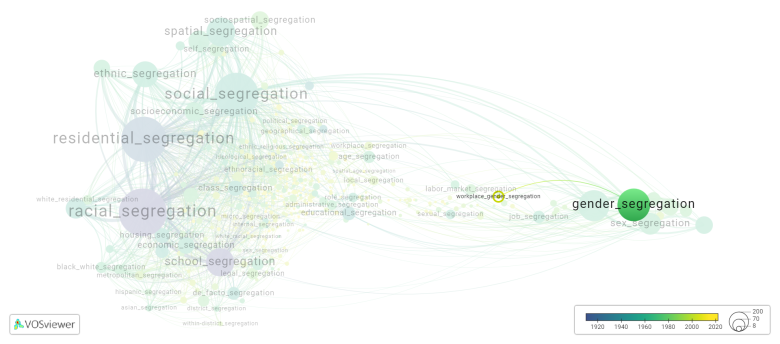Workplace gender segregation: Difference between revisions
(Creating page) |
(Creating page) |
||
| Line 18: | Line 18: | ||
Gender segregation in the workplace can be harmful as it reinforces gender stereotypes, limits gender diversity, and can result in unequal treatment and opportunities. Efforts to promote gender equality, diversity, and inclusion are essential to overcome workplace gender segregation. | Gender segregation in the workplace can be harmful as it reinforces gender stereotypes, limits gender diversity, and can result in unequal treatment and opportunities. Efforts to promote gender equality, diversity, and inclusion are essential to overcome workplace gender segregation. | ||
===== Synonyms ===== | ===== Synonyms ===== | ||
The following terms are synonymous with: | The following terms are synonymous with workplace gender segregation: | ||
gender workplace segregation. | gender workplace segregation. | ||
| Line 30: | Line 30: | ||
[[File:workplace_gender_segregation.png|780x780px]] | [[File:workplace_gender_segregation.png|780x780px]] | ||
This visualization is based on the study [[How_to_cite_Segregation_Wiki| The Multidisciplinary Landscape of Segregation Research]]. | |||
For the complete network of | For the complete network of interrelated segregation forms, please refer to: | ||
* | * [https://tinyurl.com/2235lkhw First year of publication] | ||
* | * [https://tinyurl.com/2d8wg5n3 Louvain clusters] | ||
* | * [https://tinyurl.com/223udk5r Betweenness centrality] | ||
* | * [https://tinyurl.com/244d8unz Disciplines in which segregation forms first emerged (Scopus database).] | ||
==References== | ==References== | ||
==Notes== | ==Notes== | ||
Revision as of 07:49, 10 October 2024
Date and country of first publication[1]
2013
United States
Definition
Workplace gender segregation refers to the practice of segregating or separating employees based on their gender in the workplace. This can happen in several ways:
1. Occupational segregation: Certain occupations or industries are traditionally dominated by either male or female employees. For example, nursing and teaching have historically been female-dominated professions, while engineering and construction have been predominantly male professions.
2. Job assignment: Employers may assign certain tasks or roles to employees based on their gender stereotypes. For instance, male employees may be assigned physically demanding or technical jobs, while female employees may be given administrative or customer service roles.
3. Workplace culture: Workplace culture can also contribute to gender segregation. Women may face discrimination or bias in male-dominated environments, making it challenging for them to thrive or progress. This can result in a lack of diversity in senior or leadership positions.
4. Separation in workspaces: In some cases, workplace physical spaces may be segregated by gender. This has been more common in areas like changing rooms, restrooms, or locker rooms, to maintain privacy and safety. However, this practice is becoming less common with the growth of gender-neutral facilities.
5. Limited opportunities: Gender segregation can result in limited access to opportunities, resources, and networks. This can hinder career growth and perpetuate gender inequalities in terms of promotions, pay, and decision-making power.
Gender segregation in the workplace can be harmful as it reinforces gender stereotypes, limits gender diversity, and can result in unequal treatment and opportunities. Efforts to promote gender equality, diversity, and inclusion are essential to overcome workplace gender segregation.
Synonyms
The following terms are synonymous with workplace gender segregation:
gender workplace segregation.
References and literature addressing this segregation form under these synonymous terms can be found below.
See also
Related segregation forms
Workplace gender segregation is frequently discussed in the literature with the following segregation forms:
gender segregation, occupational segregation, occupational gender segregation, social segregation

This visualization is based on the study The Multidisciplinary Landscape of Segregation Research.
For the complete network of interrelated segregation forms, please refer to:
References
Notes
- ↑ Date and country of first publication as informed by the Scopus database (December 2023).
At its current state, this definition has been generated by a Large Language Model (LLM) so far without review by an independent researcher or a member of the curating team of segregation experts that keep the Segregation Wiki online. While we strive for accuracy, we cannot guarantee its reliability, completeness and timeliness. Please use this content with caution and verify information as needed. Also, feel free to improve on the definition as you see fit, including the use of references and other informational resources. We value your input in enhancing the quality and accuracy of the definitions of segregation forms collectively offered in the Segregation Wiki ©.
Workplace gender segregation appears in the following literature
Cohen P.N. (2013). The persistence of workplace gender segregation in the us. Sociology Compass, 7(11), 889-899. https://doi.org/10.1111/soc4.12083
Stainback K., Kleiner S., Skaggs S. (2016). Women in Power: Undoing or Redoing the Gendered Organization?. Gender and Society, 30(1), 109-135. SAGE Publications Inc..https://doi.org/10.1177/0891243215602906
Taylor T., Turgeon B., Buck A., Bloch K., Church J. (2019). Spatial Variation in U.S. Labor Markets and Workplace Gender Segregation: 1980 2005*. Sociological Inquiry, 89(4), 703-726. Blackwell Publishing Inc..https://doi.org/10.1111/soin.12279
Salem R., Yount K.M. (2019). Structural accommodations of patriarchy: Women and workplace gender segregation in Qatar. Gender, Work and Organization, 26(4), 501-519. Blackwell Publishing Ltd.https://doi.org/10.1111/gwao.12361
